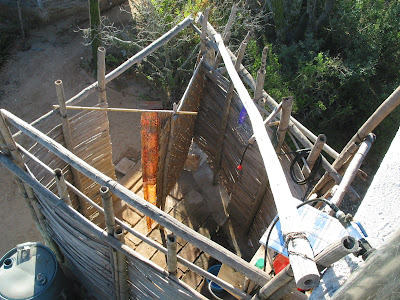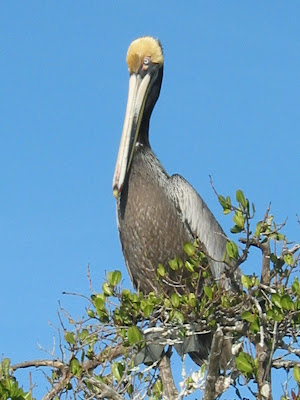Here is their website: http://alamoswildlands.org/

6-7 students each winter come for a quarter to study birds and plant life here. They make bird counts, capture and tag birds, count/identify plants in grids, etc. The students live at the field station in the canvas tents you see in this picture.

Moving right again. Here you get a sense of the organ pipe cactus forest that is all around. But it is in danger of being wiped out. This area has the most extensive area of virgin organ pipe cactus in Mexico and the world. It is still be bull-dozed down to make way for irrigated crops that are being sent to the US. It needs to stop! You can help by donating to the Alamos Wildlife Alliance so they can purchase land here and preserve it.

I am taking these pictures atop a cement building that serves as storage, student "lab" , etc. Here you see the shower for the camp. The camp has no power except from a few solar panels. Water is heated by propane for the shower. The water is actually hauled to the site and pumped into a huge tank on top of this building and is gravity fed to the shower and to the kitchen. In the kitchen there are two propane two-burner stoves and an earthen oven fired by mesquite wood.

Rotating right again. Here you see one of the 4 palapas. These structures are made of woven bamboo and then covered in a mud/straw mixture. The roof material is bamboo supports with recycled banner material. You can rent one of these to stay in or camp with a tent.

Here you can just see the kitchen, to the left of the person and the common eating area, forward and to the right of the person. In the background is some of the estuary. The land beyond is a mangrove island.


Inside the kitchen and the earthen stove.

The boa constrictor that lives in the kitchen to keep rats out. Not sure he/she does much in the cooler temps of the winter. It was in the 50's at nite and in the 70s/low 80s during the day. Perfect!


Part of the full accomodation deal is use of the kayaks. The mangrove islands have channels that are navigable during high tide. Here we are winding our way thru one of the channels. Really neat.






We traveled to a nearby ranch to see some different birds. On this ranch, lives a fellow who is a bit of an artist. Here are some of his sculptures.






There were 6 students from Evergreen College in Olympia, Washington living at the station for a quarter. Each morning they would go out and do bird counts and identify plants and do plant counts at different grids. A few times during their stay they would go out and net birds to identify them and tag them.


Catch of the day. Don't ask me what they are. But I can say they were yummy on the grill!!
 Some mornings the fog was pretty thick. By 9 or 10 it was burned off and another sunny would be had.
Some mornings the fog was pretty thick. By 9 or 10 it was burned off and another sunny would be had.
 To get to the Sea of Cortez you had to kayak about 20-30 minutes across the estuary, beach the kayak and walk across some sandy scrub for about 5 minutes. Once there you had about 10 miles of deserted beach to yourself. But because it is deserted beach, no one is there to clean up all the garbage that has washed up on the shore. It is pretty bad. Tons of plastic bottles.
To get to the Sea of Cortez you had to kayak about 20-30 minutes across the estuary, beach the kayak and walk across some sandy scrub for about 5 minutes. Once there you had about 10 miles of deserted beach to yourself. But because it is deserted beach, no one is there to clean up all the garbage that has washed up on the shore. It is pretty bad. Tons of plastic bottles.


 Every nite flocks and flocks of brown/white pelicans, frigates, cormorants and other birds fly from the north end of the estuary to points south for the nite. A count is made by someone at the camp each nite down by the shore of the estuary. It is a lovely way to end the day as the sun goes down.
Every nite flocks and flocks of brown/white pelicans, frigates, cormorants and other birds fly from the north end of the estuary to points south for the nite. A count is made by someone at the camp each nite down by the shore of the estuary. It is a lovely way to end the day as the sun goes down. Darcie and I got up early one morning so we could take a long walk along the Sea of Cortez beach. As we were kayaking along we were blessed with this amazing sunrise.
Darcie and I got up early one morning so we could take a long walk along the Sea of Cortez beach. As we were kayaking along we were blessed with this amazing sunrise.























